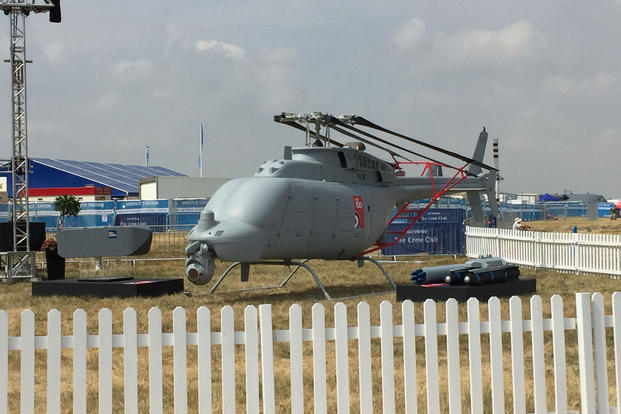RAF Fairford, England -- Northrop Grumman Corp. is looking to expand sales of its MQ-8C Fire Scout abroad as the unmanned helicopter preps for its anti-submarine warfare mission.
Sitting buttoned-up on the flightline here, the Fire Scout drone -- complete with the U.K.-based Ultra Electronics' sonobuoy mission pod -- is receiving exposure just weeks after completing the first set of mission tests of its target identification, surveillance and surface warfare abilities aboard the USS Coronado.
"They've matured it to a level now where [people are] recognizing the value in different missions it is able to do and the [U.S. Navy] is very excited about expanding that capability," said Brian Chappel, Northrop's sector vice president and general manager of autonomous systems.
Military.com sat down with Chappel during the Royal International Air Tattoo here. Northrop did not showcase the UAS at Farnborough.
"Some of those missions are going to be very interesting to customers around the world. Antisubmarine warfare, communication nodes, support to service action groups, and also with beginning to see a shift in the export policy around this class of system in the U.S., we think there's an opportunity now to take this system and its capability and what it does and find some fertile ground overseas," he said.
Related content:
- US Still Hopes to Sway Turkey to Buy Patriot Missiles over S-400
- Air Force Slowly Building Up in Eastern Europe: USAFE Commander
- Military.com Farnborough Airshow Coverage
Chappel's comments come as the Trump administration on Monday finalized its Conventional Arms Transfer (CAT) Policy. The State Department recently approved the policy, which aims to relax export rules as well as create channels for U.S. defense industry to sell weapons and drones to international customers without U.S. government sign-off.
"We're in various stages in providing information to [partners] through the Navy," Chappel continued. "And by bringing it here [during] the 100th anniversary of the Royal Air Force, a lot of different forces, a lot of people to talk to here that wouldn't normally think about a Fire Scout, and we get to … tell them how it's a little bit different than just unmanning a helicopter that flies by itself."
The Navy, which is set to use Fire Scout aboard its Littoral Combat Ships, is working with Northrop to add different capabilities, Chappel said.
"There's a radar that's now being implemented on the system that when it goes operational, will extend the horizon [of it] hundreds of miles beyond," he said, referring to Leonardo's Osprey 30 lightweight active electronically scanned array radar, as well as common datalink Link 16.
The UAS is a stripped-down version of the Bell 407. While the anti-sub mission pod would also be an enhancement, it is not currently used by the Navy.
The Fire Scout also participated in the U.S. Navy-led RIMPAC exercises this month. The drone can stay airborne for 12 hours and fly at a ceiling of 16,000 feet. Its radar range lets it see roughly 100 miles out to detect a surface target.
Chappel estimates that in 10 years additional U.S. units will be using the drone, as well as allies. He said it will evolve for different mission sets.
"Do you want it to be an [anti-sub warfare] platform today, and a comms node tomorrow or mixing and matching … in between?" he said, adding that additional sensors could be integrated for range. "That type of flexibility will make it very attractive."
-- Oriana Pawlyk can be reached at oriana.pawlyk@military.com. Follow her on Twitter at @Oriana0214.










